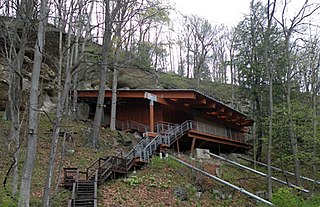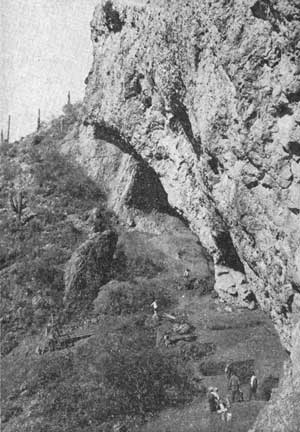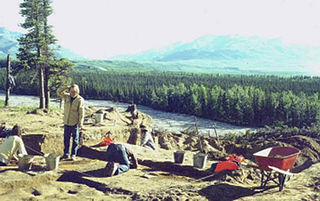Topper is an archaeological site located along the Savannah River in Allendale County, South Carolina, United States. It is noted as a location of artifacts which some archaeologists believe to indicate human habitation of the New World earlier than the Clovis culture. The latter were previously believed to be the first people in North America.

The Meadowcroft Rockshelter is an archaeological site which is located near Avella in Jefferson Township, Pennsylvania. The site is a rock shelter in a bluff overlooking Cross Creek, and contains evidence that the area may have been continually inhabited for more than 19,000 years. If accurately dated, it would be one of the earliest known sites with evidence of a human presence and continuous human occupation in the New World.

The Adams County Paleo-Indian District is an archaeological site near Sandy Springs in Green Township, Adams County, Ohio, United States.
The East Wenatchee Clovis Site is a deposit of prehistoric Clovis points and other implements, dating to roughly 11,000 radiocarbon years before present or about 13,000 calendar years before present, found near the city of East Wenatchee, Washington in 1987. Accidentally discovered in an apple orchard by Mark Mickels, it yielded some of the largest stone Clovis points known to science. After controversy over its excavation, the site was sealed off from further digging from 1992 until 2007.

The Double Adobe site is an archaeological site in southern Arizona, twelve miles northwest of Douglas in the Whitewater Draw area. In October 1926, just three months after the first human artifact was uncovered at the Folsom site, Byron Cummings, first Head of the Archaeology Department at the University of Arizona, led four students to Whitewater Draw. Discovered by a schoolboy, the Double Adobe site contained the skull of a mammoth overlying a sand layer containing stone artifacts. One of these students was Emil Haury.

Ventana Cave is an archaeological site in southern Arizona. It is located on the Tohono O'odham Indian Reservation. The cave was excavated under the direction of Emil Haury by teams led by Julian Hayden in 1942, and in 1941 by a team led by Wilfrid C Bailey, one of Emil Haury's graduate students. The deepest artifacts from Ventana Cave were recovered from a layer of volcanic debris that also contained Pleistocene horse, Burden's pronghorn, tapir, sloth, and other extinct and modern species. A projectile point from the volcanic debris layer was compared to the Folsom Tradition and later to the Clovis culture, but the assemblage was peculiar enough to warrant a separate name – the Ventana Complex. Radiocarbon dates from the volcanic debris layer indicated an age of about 11,300 BP.

The Dry Creek Archeological Site is an archaeological site not far outside Denali National Park and Preserve. It is a multi-component site, whose stratified remains have yielded evidence of human occupation as far back as 11,000 years ago. The site is located on the northern flanks of the Alaska Range, near Healy, Alaska, in the Nenana River watershed. There are four major components to the site, layered in an outwash terrace overlooking Dry Creek, with layers of loess separating them.

The Thunderbird Archaeological District, near Limeton, Virginia, is an archaeological district described as consisting of "three sites—Thunderbird Site, the Fifty Site, and the Fifty Bog—which provide a stratified cultural sequence spanning Paleo-Indian cultures through the end of Early Archaic times with scattered evidence of later occupation."

The Manis Mastodon site is a 2-acre (1 ha) archaeological site on the Olympic Peninsula near Sequim, Washington, United States, discovered in 1977. During the 1977-78 excavation, the remains of an American mastodon were recovered with a 13,800-year-old projectile point made of the bone from a different mastodon embedded in its rib. The site was placed on the National Register of Historic Places in 1978.

Blackwater Draw is an intermittent stream channel about 140 km (87 mi) long, with headwaters in Roosevelt County, New Mexico, about 18 km (11 mi) southwest of Clovis, New Mexico, and flows southeastward across the Llano Estacado toward the city of Lubbock, Texas, where it joins Yellow House Draw to form Yellow House Canyon at the head of the North Fork Double Mountain Fork Brazos River. It stretches across eastern Roosevelt County, New Mexico, and Bailey, Lamb, Hale, and Lubbock Counties of West Texas and drains an area of 1,560 sq mi (4,040 km2).

Cedar Swamp Archeological District is a prehistoric and historic archaeologically sensitive area in eastern Westborough, Massachusetts, and extending into the northwest corner of Hopkinton. Cedar Swamp is an area of more than 2,600 acres (1,100 ha) of wetlands that include the headwaters area of the Sudbury River. Archeological surveys of the environmentally sensitive and critical area have identified many Native American sites of interest. It is believed that Native Americans prized wood from the cedar trees that grew in the area. The archeological district, which encompasses much of the Cedar Swamp area, was added to the National Register of Historic Places in 1988.

The Riverside Archeological District is a historic archaeological site in Gill and Greenfield, Massachusetts. The site added to the National Register of Historic Places in 1975.
The Witt Site is an archaeological site near Tulare Lake in Kings County, California. It was found by Donald Witt, who collected artifacts of concave points, crescents, and fossilized elephant, bison, and horse bones. The site was apparently a good location for ambushing large mammals coming to the lake.
The Paw Paw Cove Site is an archaeological site on the coast of Talbot County, Maryland. The site, first identified in 1979, is a complex of three locations on 500 metres (1,600 ft) of shoreline on Chesapeake Bay, at which stone artifacts with an estimated date of 11,500 to 10,500 BCE have been found. Among the finds are fluted projectile points and flakes created during the manufacture of such points.

The Anzick site (24PA506) in Park County, Montana, United States, is the only known Clovis burial site in the New World. The term "Clovis" is used by archaeologists to define one of the New World's earliest hunter-gatherer cultures and is named after the site near Clovis, New Mexico, where human artifacts were found associated with the procurement and processing of mammoth and other large and small fauna.

The Spiller Farm Paleoindian Site, designated Site 4.13 by the Maine Archaeological Survey, is a prehistoric archaeological site in Wells, Maine. Located overlooking a stream on the Spiller Farm property on Branch Road, it is an extensive site at which a fine collection of stone artifacts has been found, dating to c. 8,000 BCE. The site was listed on the National Register of Historic Places in 2003.
The Heaven's Half Acre complex is a concentration of Paleoindian sites situated on a series of Pleistocene terraces overlooking a sinkhole in northeastern Colbert County, Alabama, near the town of Leighton. Over one hundred and fifty fluted points have been recovered on these sites, making it one of the most dense fluted point localities in North America.

The Tobin's Beach Site is a prehistoric archaeological site in Brookfield, Massachusetts. Discovered in 1963, it is one of a small number of sites in New England known for preserving elements of the Adena culture. The site was declared eligible for listing on the National Register of Historic Places in 1986, and was formally listed in an enlarged state in 2018.

Paleo Crossing site, also known as the Old Dague Farm site, is an archaeological site near Sharon Center, Ohio in Medina County where Clovis artifacts dated to 10,980 BP ± 75 years Before Present were found. The Cleveland Museum of Natural History conducted an excavation from 1990 to 1993. The site provides evidence of Paleo-Indians in northern Ohio and may be the area's oldest residents and archaeologist Dr. David Brose believes that they may be "some of the oldest certain examples of human activity in the New World." The site contains charcoal recovered from refuse pits. There were also two post holes and blades and tools 80% of which were made from flint from the Ohio River Valley in Indiana, 500 miles from Paleo Crossing, which indicates that the hunter-gatherers had a widespread social network and traveled across distances relatively quickly. The post holes are evidence that there was a shelter built on the site.
Nobles Pond site is a 25-acre archaeological site near Canton in Stark County, Ohio, and is a historical site with The Ohio Historical Society. It is one of the largest Clovis culture sites in North America. At the end of the Ice age, about 10,500 to 11,500 years ago, a large number of Paleo-Indians, the first people to live in Ohio, camped at the site. Artifacts on the site, primarily excavated by volunteers, provide insight into how they made and used tools, obtained materials, and how they lived.

















